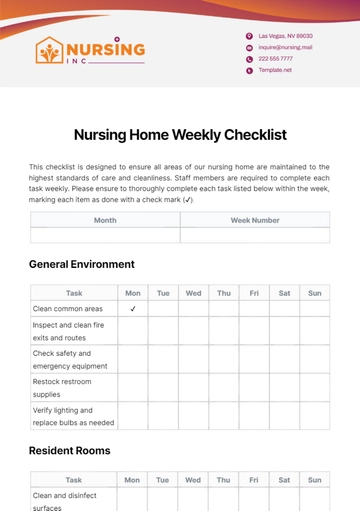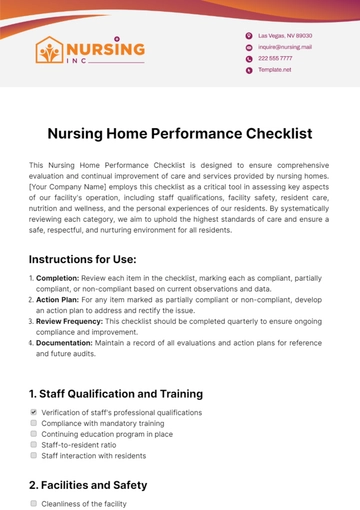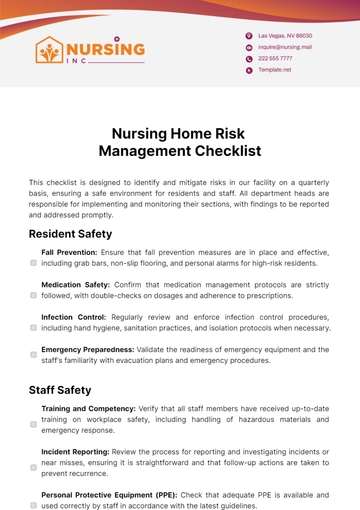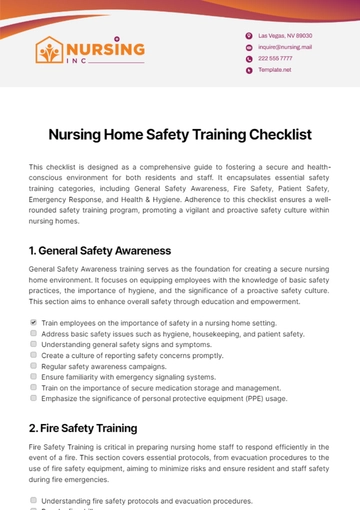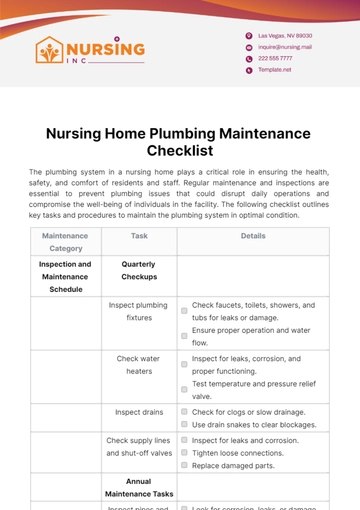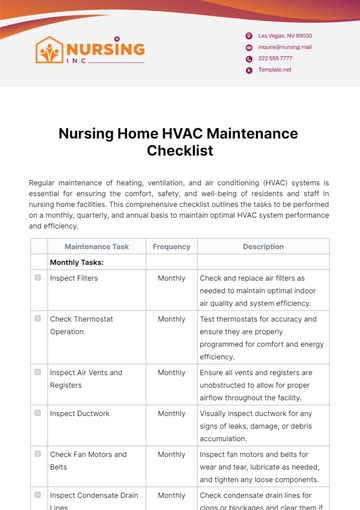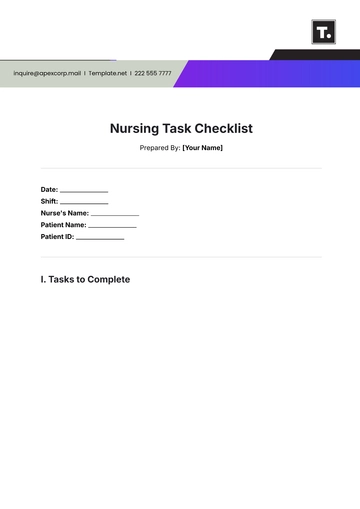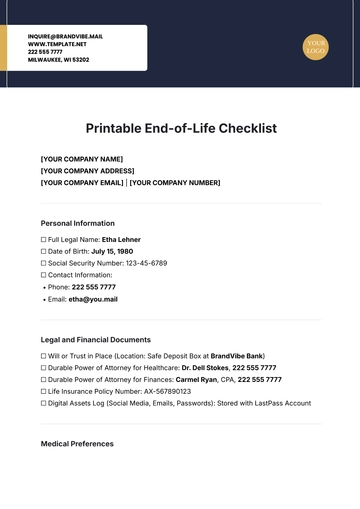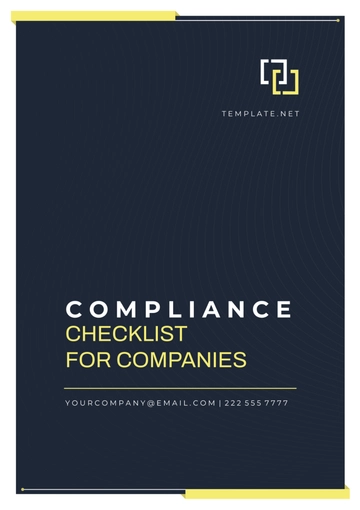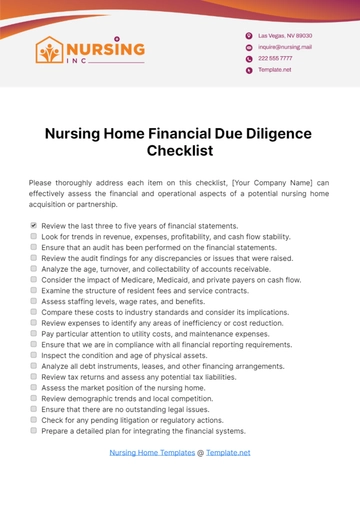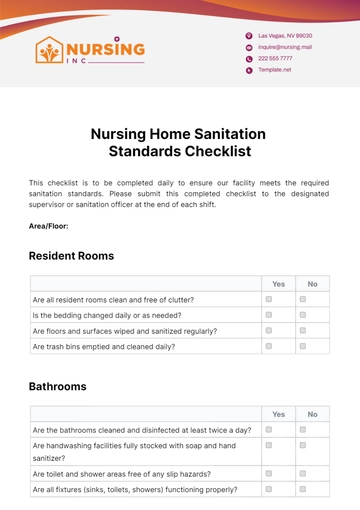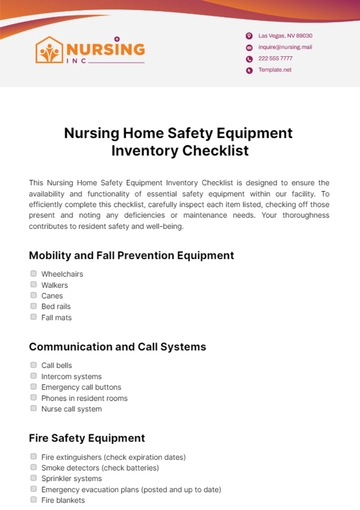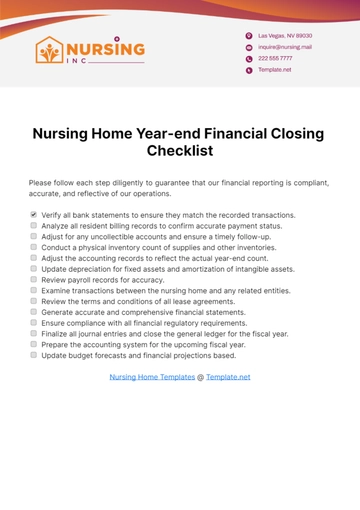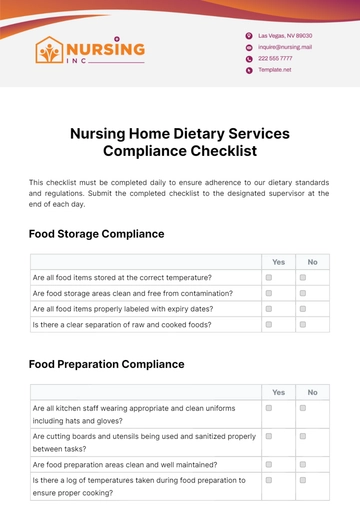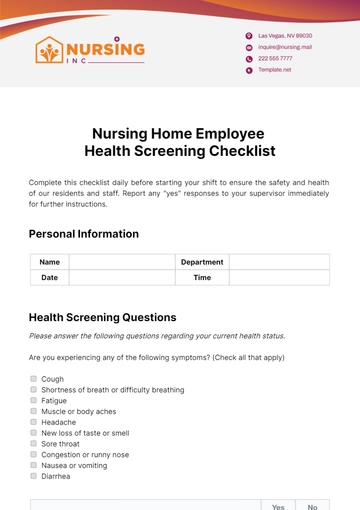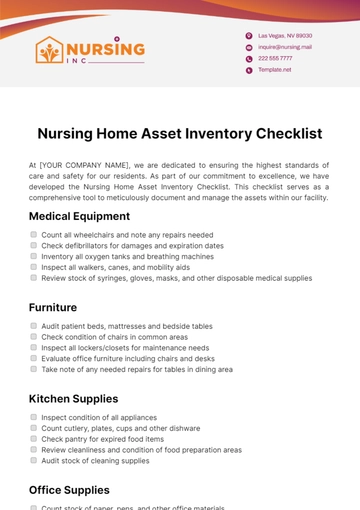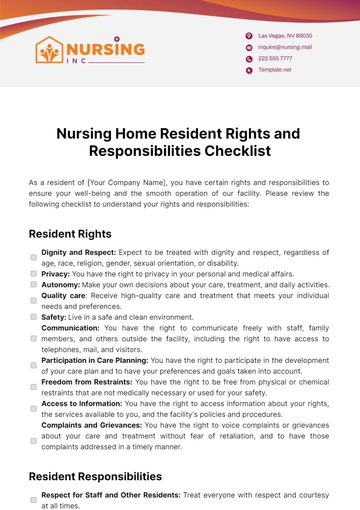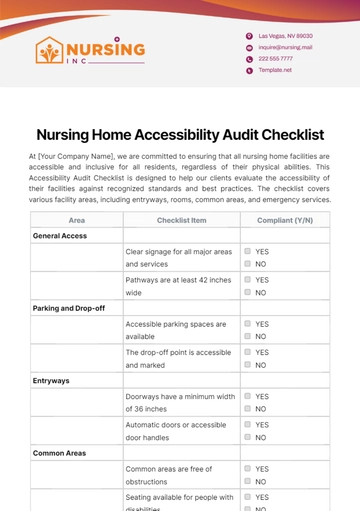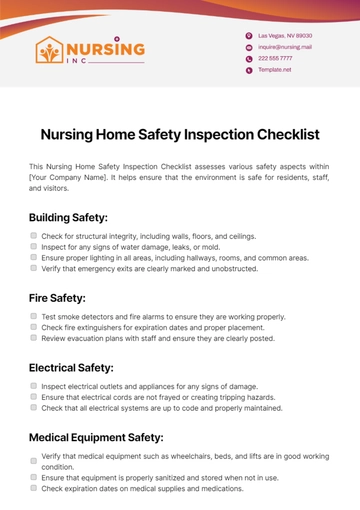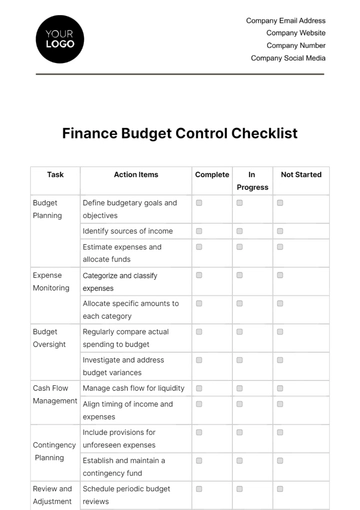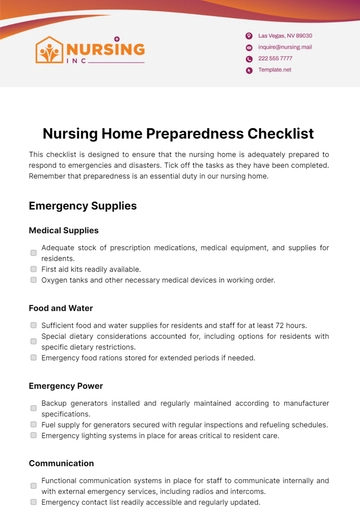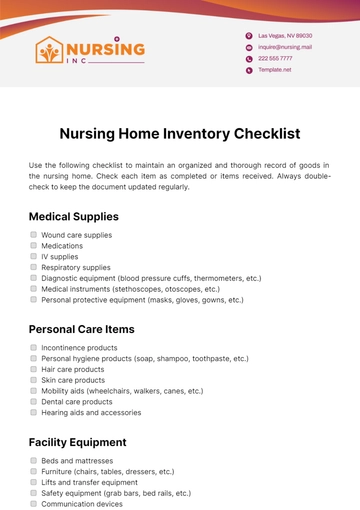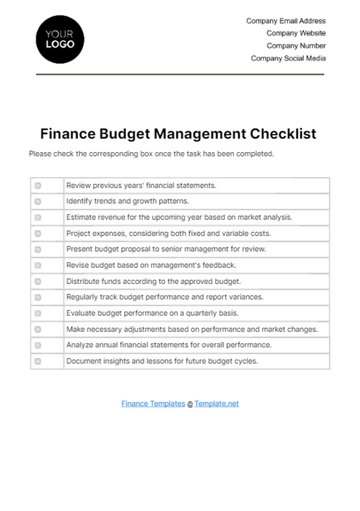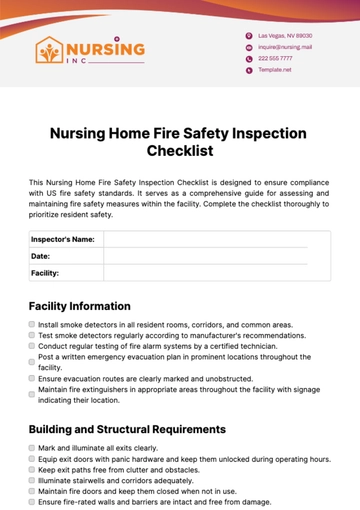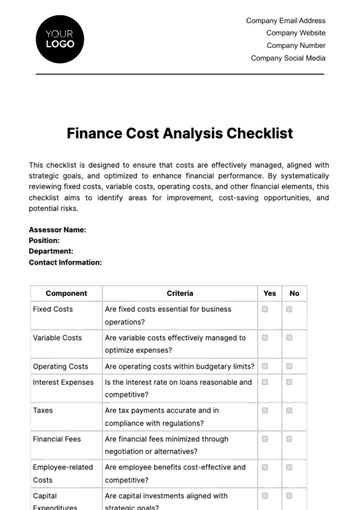Free Nursing Home Inspection Checklist
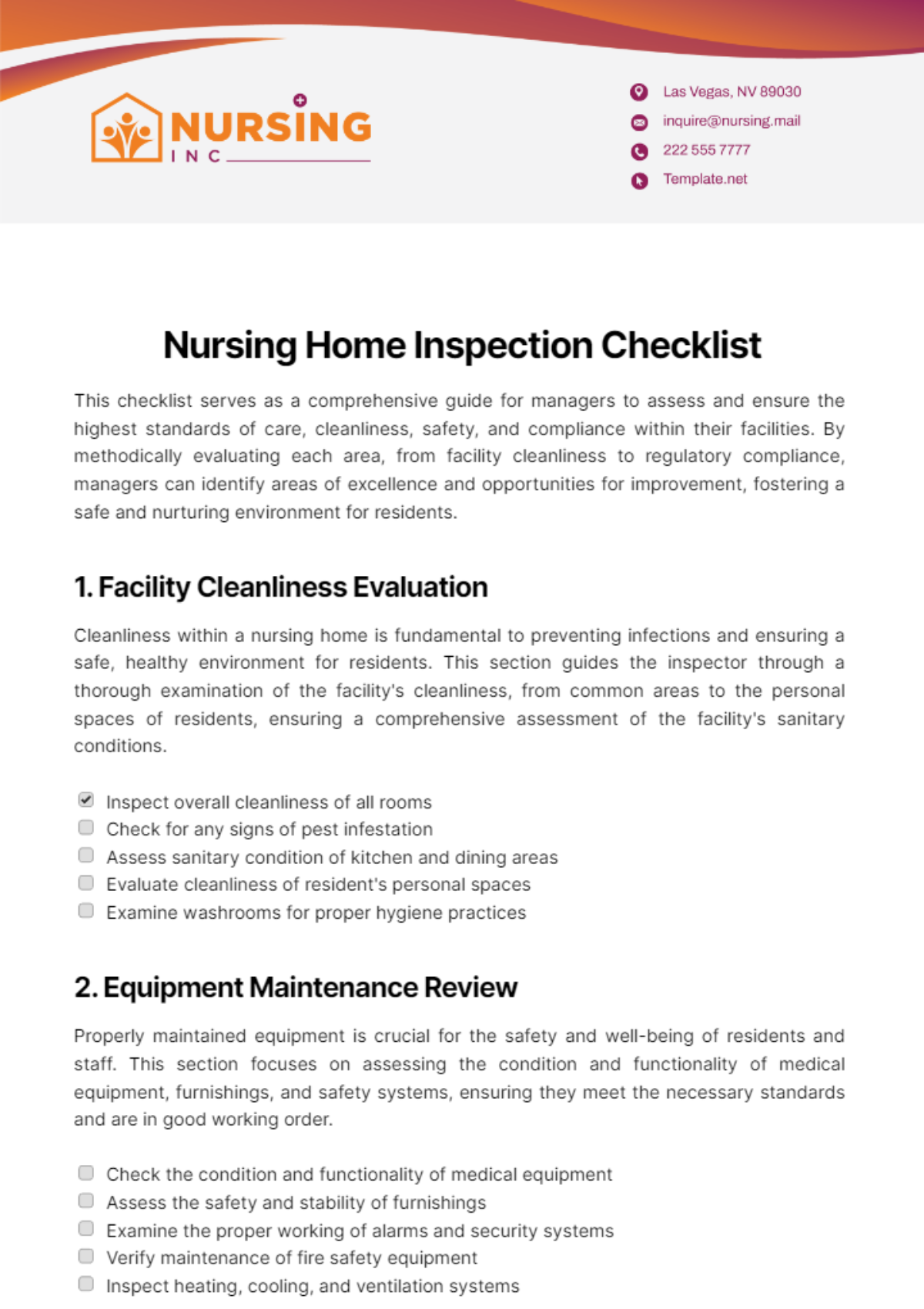
This checklist serves as a comprehensive guide for managers to assess and ensure the highest standards of care, cleanliness, safety, and compliance within their facilities. By methodically evaluating each area, from facility cleanliness to regulatory compliance, managers can identify areas of excellence and opportunities for improvement, fostering a safe and nurturing environment for residents.
1. Facility Cleanliness Evaluation
Cleanliness within a nursing home is fundamental to preventing infections and ensuring a safe, healthy environment for residents. This section guides the inspector through a thorough examination of the facility's cleanliness, from common areas to the personal spaces of residents, ensuring a comprehensive assessment of the facility's sanitary conditions.
Inspect overall cleanliness of all rooms
Check for any signs of pest infestation
Assess sanitary condition of kitchen and dining areas
Evaluate cleanliness of resident's personal spaces
Examine washrooms for proper hygiene practices
2. Equipment Maintenance Review
Properly maintained equipment is crucial for the safety and well-being of residents and staff. This section focuses on assessing the condition and functionality of medical equipment, furnishings, and safety systems, ensuring they meet the necessary standards and are in good working order.
Check the condition and functionality of medical equipment
Assess the safety and stability of furnishings
Examine the proper working of alarms and security systems
Verify maintenance of fire safety equipment
Inspect heating, cooling, and ventilation systems
3. Staff Qualifications and Performance
The qualifications and performance of the staff directly impact the quality of care provided to residents. This section emphasizes the verification of staff credentials, assessment of staffing levels, and evaluation of staff training and interactions, ensuring a high standard of care and professionalism.
Verify all staff credentials and licenses
Assess the staff-to-resident ratio
Evaluate care plan development and implementation
Review staff training programs and update needs
Evaluate staff interactions with residents
4. Resident Satisfaction Evaluation
Resident satisfaction is a key indicator of the quality of life in a nursing home. This section focuses on gathering feedback from residents regarding their care, meals, and the provision of recreational activities, aiming to enhance the personalization and enjoyment of their living spaces.
Conduct resident satisfaction surveys
Observe resident behavior and mood
Assess quality of meals and resident feedback
Check provision of recreational and social activities
Evaluate personalization of living spaces
5. Regulatory Compliance
Compliance with regulatory standards is non-negotiable for the operation of nursing homes. This section guides inspectors through verifying adherence to health codes, reviewing emergency plans, and evaluating drug management systems, ensuring the facility meets all legal and safety requirements.
Verify compliance with local and national health codes
Check for any outstanding legal issues
Review policies on resident health, safety, and rights
Assess emergency evacuation plans
Evaluate drug management and control system
Prepared By: [Your Name]
- 100% Customizable, free editor
- Access 1 Million+ Templates, photo’s & graphics
- Download or share as a template
- Click and replace photos, graphics, text, backgrounds
- Resize, crop, AI write & more
- Access advanced editor
Maximize efficiency and thoroughness with Template.net's Nursing Home Inspection Checklist Template. This is an editable and customizable document, tailored to meet industry standards. Seamlessly editable in our Ai Editor Tool, this template ensures you don't miss any crucial details during inspections. Engage with our template to deliver optimal inspection reports, enhance the healthcare service quality, and uphold rigorous standards in nursing home care.
You may also like
- Cleaning Checklist
- Daily Checklist
- Travel Checklist
- Self Care Checklist
- Risk Assessment Checklist
- Onboarding Checklist
- Quality Checklist
- Compliance Checklist
- Audit Checklist
- Registry Checklist
- HR Checklist
- Restaurant Checklist
- Checklist Layout
- Creative Checklist
- Sales Checklist
- Construction Checklist
- Task Checklist
- Professional Checklist
- Hotel Checklist
- Employee Checklist
- Moving Checklist
- Marketing Checklist
- Accounting Checklist
- Camping Checklist
- Packing Checklist
- Real Estate Checklist
- Cleaning Checklist Service
- New Employee Checklist
- Food Checklist
- Home Inspection Checklist
- Advertising Checklist
- Event Checklist
- SEO Checklist
- Assessment Checklist
- Inspection Checklist
- Baby Registry Checklist
- Induction Checklist
- Employee Training Checklist
- Medical Checklist
- Safety Checklist
- Site Checklist
- Job Checklist
- Service Checklist
- Nanny Checklist
- Building Checklist
- Work Checklist
- Office Checklist
- Training Checklist
- Website Checklist
- IT and Software Checklist
- Performance Checklist
- Project Checklist
- Startup Checklist
- Education Checklist
- Home Checklist
- School Checklist
- Maintenance Checklist
- Planning Checklist
- Manager Checklist
- Wedding Checklist
- Vehicle Checklist
- Travel Agency Checklist
- Vehicle Inspection Checklist
- Interior Design Checklist
- Backpacking Checklist
- Business Checklist
- Legal Checklist
- Nursing Home Checklist
- Weekly Checklist
- Recruitment Checklist
- Salon Checklist
- Baby Checklist
- Equipment Checklist
- Trade Show Checklist
- Party Checklist
- Hospital Bag Checklist
- Evaluation Checklist
- Agency Checklist
- First Apartment Checklist
- Hiring Checklist
- Opening Checklist
- Small Business Checklist
- Rental Checklist
- College Dorm Checklist
- New Puppy Checklist
- University Checklist
- Building Maintenance Checklist
- Work From Home Checklist
- Student Checklist
- Application Checklist

